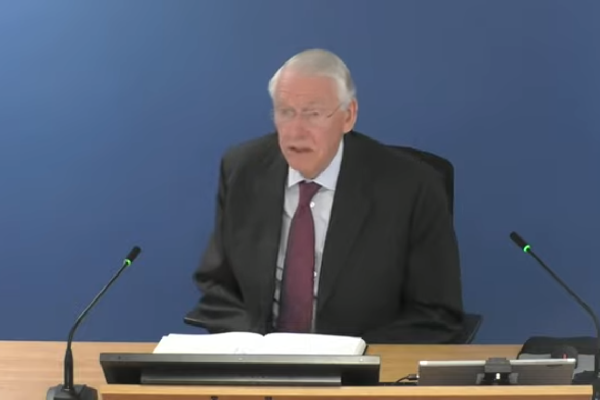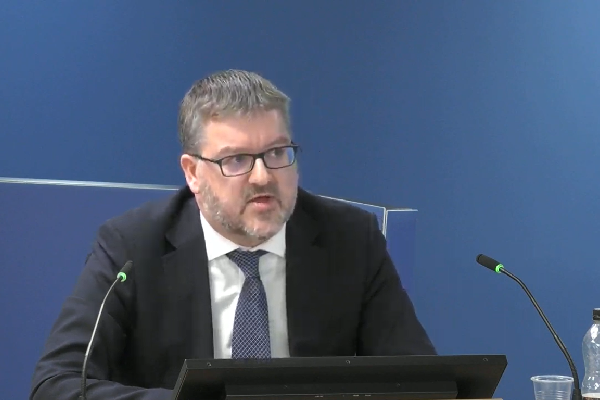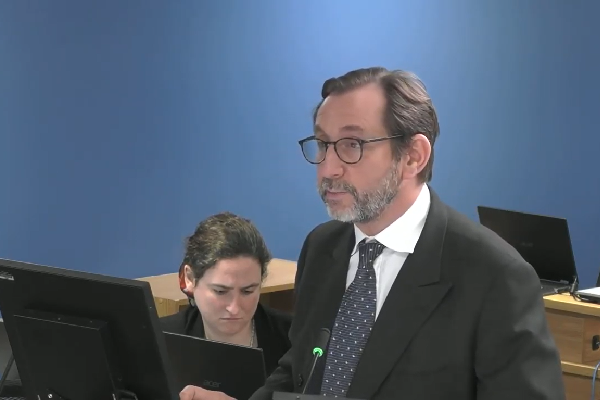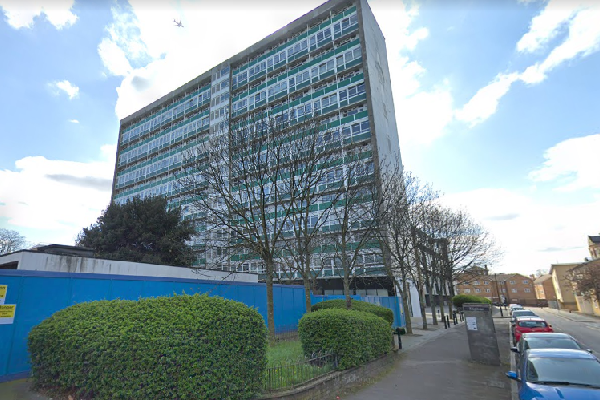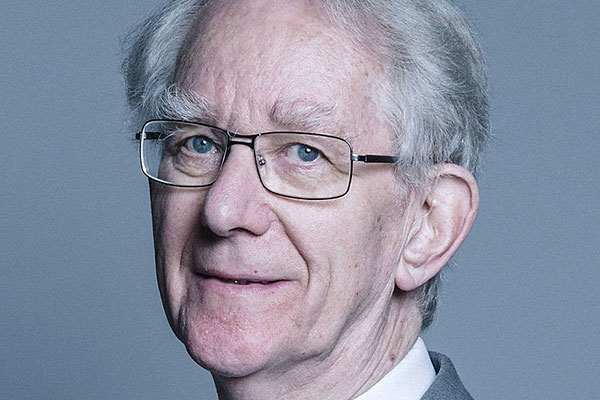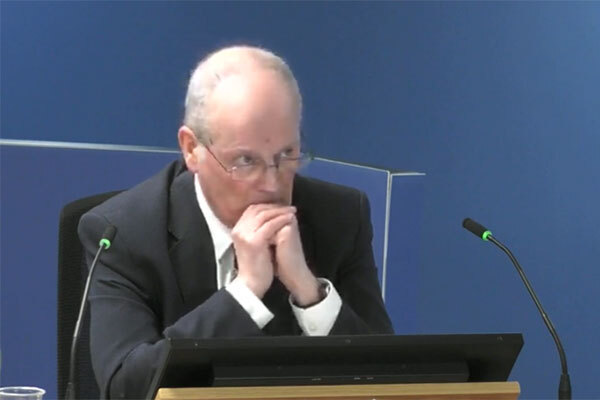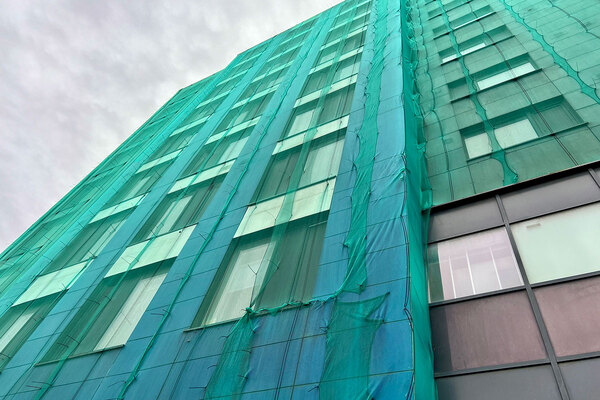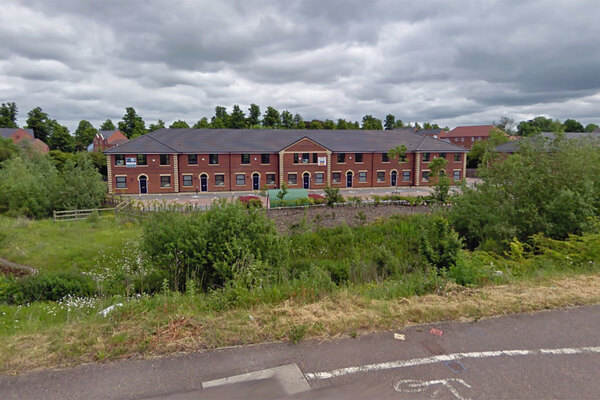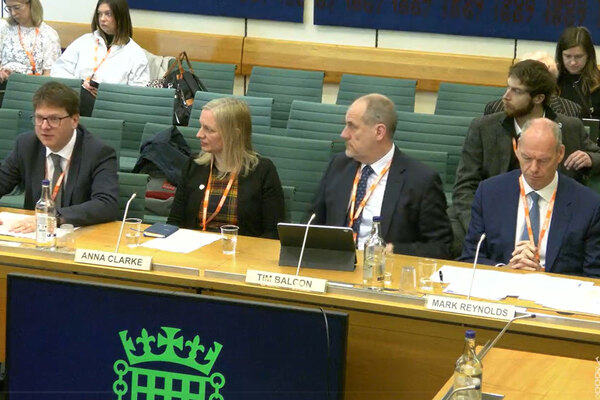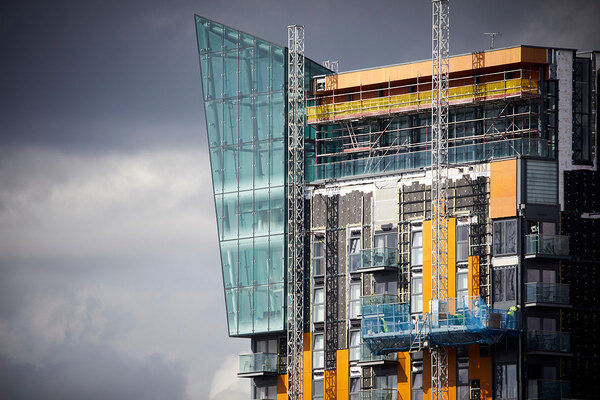Grenfell Tower Inquiry diary week 66: ‘Was there a cover up?’
The latest evidence from the Grenfell Tower Inquiry tracked the government’s failure to act on fire safety warnings right up until the months before the fire. Peter Apps and Grainne Cuffe report
This week the Grenfell Tower Inquiry continued to hear from former civil servants, with Anthony Burd and Bob Ledsome taking the stand.
Both were previously senior figures in the government division responsible for building regulations and both were grilled on why more was not done to clearly outlaw dangerous cladding in the years before the Grenfell Tower fire.
The week gave us the first look at the evidence covering a crucial period for the inquiry: the years following the recommendation of a coroner in March 2013 that fire safety rules be reviewed.
Our review begins in the year 2001, with more evidence surrounding the mock cladding tests carried out by the Building Research Establishment (BRE).
‘Given the fact that not publishing it was unusual, was there a cover-up?’
This week’s evidence once again began with discussion of a testing programme on a variety of cladding systems in the early 2000s.
To set the background: the government had agreed to introduce a new large-scale cladding test designed by the BRE, which was running a series of mock tests to establish an appropriate pass/fail criteria.
The programme resulted in tests of 14 systems between May and November 2001. The inquiry has focused on one of these tests carried out on 18 July 2001, which contained the same type of aluminium composite material (ACM) cladding that was later installed on Grenfell Tower.
The 2001 test failed disastrously. It exceeded the set failure criteria just three minutes into the 30-minute test, spread 20-metre-high flames after five minutes and was halted to protect the safety of those present 45 seconds later.
“Would you agree that this [the ACM test] is a catastrophic escalation of the fire?” asked Richard Millett QC, lead counsel to the inquiry.
“It was a very fierce, fast fire,” replied Mr Burd.
“Were you left in any doubt at all at this time that the use of aluminium rainscreen panels with a polyethylene core when used at height, presented a serious risk to life?” asked Mr Millett.
“I’m trying to recall what I considered at that time,” replied Mr Burd. “I envisage I would have thought that it was quite timely and correct that the learnings from this would feed in to set the ultimate pass-fail criteria for these sorts of products.”
The cladding panel used on the test had a ‘Class 0’ rating, meaning it complied with the minimum standards in official guidance, Approved Document B. Surely, this should have been a major concern for the government?
Mr Burd’s argument was that although the panels were compliant with the Class 0 standard in the guidance, they still should not have been used on buildings.
This is because they would not comply with the overriding responsibility that the walls of buildings should “adequately resist” the spread of flame, which is imposed by legislation.
He also pointed to a general warning in Approved Document B that even if materials met the basic standards, they still may present a danger.
Inquiry chair Sir Martin Moore-Bick, inquiry chair pressed Mr Burd on this point. The guidance set out a “step-by-step” guide for builders which culminated in telling them to use a Class 0 panel.
“As I understand it, your evidence is that that is all overridden by the warning… that there may be problems if you use combustible materials?” Sir Martin asked.
“Yes, sir,” replied Mr Burd.
“Did it ever occur to you that there might be people reading [the guidance] who would not get that message?” asked Sir Martin.
“I suppose there is always that potential risk,” replied Mr Burd. “I can only speak of a time when I was working in building control and then I became a regulator, is that we were always taught to read all of the approved document.”
But this argument felt terribly circular: the evidence that the panels posed such a serious risk came from the testing. And the testing was never released. So how would builders have known?
Mr Burd accepted that in the normal course of business test results like this, paid for with public money, would be made public.
“Given the fact that not publishing it was unusual, was there a cover-up?” asked Mr Millett.
“No sir,” replied Mr Burd.
“You see, some people looking at this might put to you the fact that the reason why there was a cover-up was because… the government might know that releasing these results would immediately trigger a cladding crisis,” said Mr Millett.
“I can see why people might think that but, from my perspective, there was no such cover-up,” replied Mr Burd.
‘Was this a question of balancing public safety on the one hand and market choice on the other?’
We learned last week that, even notwithstanding these tests, the Class 0 standard should have been dropped in the early 2000s at any event in favour of new tests being developed in Europe.
The Euroclass regime, which graded the fire performance of products on an alphabetic scale from ‘A1’ (the best) to ‘E’ (the worst), was being adopted around the bloc and the UK, as a member state, was supposed to harmonise its own guidance with the rest of the continent.
To do this, the first decision was which European standard should replace Class 0. This was not straightforward: the tests were totally different and could not simply be overlaid onto each other.
In the end, the government selected ‘B’. But while generally tougher than ‘Class 0’, this was a grading which would still permit the use of some combustible materials. Choosing to go one notch higher (A2) would have outlawed anything combustible.
But a report prepared for the government in May 2000 warned that A2 would “severely restrict market choice”.
“Is it right that if you said that class 0 should be equivalent to Euroclass A2, that would have been likely to have met with serious resistance from the industry?” asked Mr Millett.
“Potentially, yes,” replied Mr Burd (pictured above).
“I mean, was this a question, standing back a little bit from this, of balancing public safety on the one hand and market choice on the other?” asked Mr Millett.
Mr Burd said it was “felt that B was a good level of performance and… would sit more naturally with class 0”. He added that A2 was seen as “too demanding”.
The next question was when to make the switch from Class 0 to Euroclass B.
According to notes of meetings attended by Mr Burd in the early 2000s, a transition phase should have started in 2002, where both standards were applied. Then all new products should have been expected to meet the Euroclass B standard, with Class 0 eventually withdrawn.
This never happened. Instead, we stayed in an indefinite transition period until 2018 – a year after Grenfell – with both standards in the guidance. Why? Again, it appears industry pressure was a factor.
The issue was that some materials which could obtain Class 0 (such as foil faced insulation products) would score a C or D when tested under the Euroclass system.
The inquiry saw a letter from January 2002 sent by lobbyists for the combustible insulation sector which warned the Euroclass system could see “previously acceptable safe products… prevented from continuing in their application”. “I think you will agree this should not happen,” the letter concluded.
“Did you not see this letter as an example of industry trying to cling on to class 0, despite what you now knew of its proven unreliability?” asked Mr Millett.
“In relation to the first part of your question, in terms of wanting to cling on to the national approach, yes, I agree,” replied Mr Burd.
‘Why do it that way?’
Despite the failure to alter the guidance in the early 2000s, the relevant passages in Approved Document B did change in 2006.
The driver was a fire at a building called the Edge in Salford in 2005. The walls of this buildings were made of metal panels held together with polystyrene. The polystyrene was highly combustible and had resulted in the fire spreading from the second floor to the the top of the 19-storey building in less than 10 minutes.
The tower had recently been completed and was only partially occupied at the time of the blaze, but a report from the BRE said the fire service had “grave concerns” for the safety residents had the building been fully occupied.
Pertinently, these panels had a Class 0 rating and were therefore used in compliance with Approved Document B.
On 18 January 2005, another senior civil servant, Brian Martin, emailed to say that the “guidance is in need of clarification”. “This appears to be as a result of changes in construction practice whereby the intent of the original guidance has been circumvented,” he wrote.
He attached a potential new wording which said that insulation products and “any other material” used in an external wall should meet the standard of “limited combustibility”.
Limited combustibility is tougher than Class 0 and Mr Martin’s proposed wording would have banned combustible cladding outright.
But this was not what happened. In his email, Mr Martin said the wording still needed “some work” as in its current form it would have “prohibited timber-framed buildings”.
A redraft of Approved Document B was then written, consulted on and published in 2006.
Ultimately, the paragraph Mr Martin had identified as in need of a redraft was amended to say that “any insulation product, filler material… etc” should meet the standard of limited combustibility.
The provenance of the word ‘filler’ appears to have come from a consultation response submitted by large building control firm the National House Building Council (NHBC). But it was never formally consulted on.
Asked why further questions were not asked about its precise meaning, Mr Burd said there was not time.
But the meaning of these words was not clear and has caused an enormous amount of debate since the fire.
The government is insistent that the words “filler material” should have covered the core of an ACM panel.
But this has been disputed by many, including some of the expert witnesses engaged by the inquiry, who have argued that ‘filler’ had a much narrower meaning and that the continuing presence of the ‘Class 0’ standard in guidance meant lower standards applied to external cladding panels.
“Why do it that way? Why not say, ‘all composite rainscreen panels must be composed throughout of materials of limited combustibility’? That would have solved it,” asked Mr Millett (pictured above).
“In hindsight, sat here, I can see how it looks that way, yes,” replied Mr Burd.
He told the inquiry that the government did intend to permit the use of some combustible materials, even after this new wording was adopted and that “filler material” was not intended as a catch-all to ban everything combustible. These admissions may prove difficult for forthcoming government witnesses, given claims made about the application of the guidance since the Grenfell Tower fire.
‘I suggest we need to be very careful here… we don’t want to start any hares running’
In 2009, a fire tore through a high-rise building called Lakanal House (pictured above) in south London and killed six people including three children.
We have already heard a nascent investigation by the BRE for the government was “shut down” just weeks after the blaze.
But the BRE then began investigating for the Metropolitan Police. In December 2009, Sir Ken Knight, a senior advisor to the government, emailed Mr Burd and Mr Martin to notify them that tests on the panels installed on the outside of Lakanal showed they were “demonstrated to propagate flame”.
The belief at the time was that they had “enhanced the vertical spread of fire from the flat of origin and may have contributed to the downward fire spread”.
Mr Burd responded to this email by writing: “I suggest we need to be very careful here… we don’t want to start any hares running.”
What did he mean by this? “I think it was just saying we need to do it properly, but we just need to have the full gamut of the evidence,” he said.
The email chain then continued with Mr Martin writing: ”Honestly. I leave you alone for 5 minutes!
“I’m not convinced about this. The pictures of… Lakanal House don’t suggest to me that the spandrels were particularly significant. It ’s nothing like Irvine [where a substantial fire had occurred in 1999].”
Less than a minute later, Mr Burd replied: “Which is why we just go for a general fire safety message − not focussed on elevations [external walls]. I promise that I do listen to you.”
Mr Burd claimed that all he meant by this was that a general fire safety message was more appropriate until the full information had been obtained.
‘Is there anything else we could scrap or amend… like insurance to replace building control?’
Shortly after this exchange, the May 2010 general election brought the Conservative and Liberal Democrat coalition to power.
This resulted in a tough line on regulation, as the government sought to cut ‘red tape’ to boost the ailing UK economy.
In September 2010, Mr Burd attended a meeting where he was told the strategy meant “regulation must be a last resort and the cost benefit analysis must stack up”.
“Did you at any time yourself consider how these policy constraints might affect how you were able to carry out your role?” asked Mr Millett.
Mr Burd said it did. “I had five technical members of staff by the time I left in 2013, and so what we found ourselves was spending an inordinate amount of time looking at how we could deregulate… which meant we couldn’t necessarily focus on the job at hand,” he said.
We got a glimpse of how far this new approach affected thinking with a document prepared for junior Liberal Democrat Andrew Stunell (pictured above) in May 2012.
The minister was preparing for a meeting with the government’s deregulation tsar Oliver Letwin and officials floated the idea of scrapping building control entirely and relying instead on private insurance.
The push against deregulation was crystalised with a new ‘one in, one out’ rule which was imposed in 2011. This meant a cost assessment had to be made of any proposed new regulation and an equivalent amount of cost stripped out by removing existing rules.
This was toughened to ‘one in, two out’ in January 2013 and ‘one in, three out’ in 2016.
Approved Document B, despite only having the status of guidance, was covered by this new rule.
Mr Burd said rules affecting housebuilding were particularly impacted as the government was keen to reduce “cost burdens” on house builders. “So there was an effective moratorium controlling what further regulations you could bring forward,” he said.
And this regulatory drive was about to smash directly into concerns about fire safety. Because in March 2013, a lengthy coroners inquest into the six deaths at Lakanal House concluded.
The coroner wrote to then-communities secretary Eric Pickles calling Approved Document B “a most difficult document to use” and recommending a review, with particular regard to the issue of external fire spread.
Mr Pickles responded in May 2013 promising a new version of the document by 2016-17. But how could this be delivered under the limitations of the new desire to limit regulation?
‘I regret that perhaps we should have given it more attention and we didn’t’
A year after Mr Pickles’ (pictured above) letter, Mr Martin, who was in charge of building regulations at the time, wrote in an email that the promise to produce a new version of the approved document was “not an absolute commitment”.
Bob Ledsome, the deputy direction of building regulations between 2011 and 2018, said he “did not know why” Mr Martin would have said that, because “there was a commitment” from the secretary of state.
The inquiry saw Mr Martin said in his witness statement that as an election was due in 2015, “another government would be in power and would not be bound by the commitments of a previous administration”.
Mr Ledsome said he could understand the reasoning, but added: “It would have been unlikely that a new government would have said, ‘oh, we’re going to completely ignore this recommendation and do something completely different’.”
Asked about the time scale of finishing the review of Approved Document B, which aimed for 2016-17, Mr Millett asked if Mr Ledsome had “allowed yourself to be overwhelmed and distracted by the complexity and the size of the task” and “lost sight of the fact that what the coroner wanted was a response which went to life safety”.
Mr Ledsome said: “I do not accept that we lost sight of life safety. I do accept that we should have thought is there an option to do something sooner?
“Yes, I accept that and I regret that perhaps we should have given it more attention and we didn’t.”
He added that had the department developed a new version of the guidance, it would have been caught by the ‘one in, two out’ process.
He also said there was a view that applying for an exemption from the rule was “not a fight worth having”.
“Was your pessimism that you described earlier in not even applying [for an exemption] grounded in the assumption that the cost−benefit principle would always trump any consideration of life safety?” asked Mr Millett.
“Well, it certainly would have made the case for change more difficult to achieve,” replied Mr Ledsome.
‘Our correspondence with the APPG is appalling: delayed, partial and looks chaotic’
In 2015, the promised review of Approved Document B was folded into a wider review of building regulations without the Lakanal coroner being updated.
This was despite Mr Pickles having effectively promised the coroner it would be undertaken individually.
Mr Ledsome (pictured above) said in his witness statement that the reason for this was because “we wanted to present the minister an overall picture of work on the building regulations, rather than make submissions in a more piecemeal fashion”.
He said it was a “collective” view, though he was ultimately responsible for the decision.
Mr Millett said: “Do you accept that locating the review of Approved Document B within a wider review of building regulations would slow the process down, perhaps by some years?”
“I accept that was a risk,” Mr Ledsome said, but he added that the division was expecting some elements of the wider review to finish earlier than others.
Mr Millett asked if the presence of that risk might “undermine” the promise made to the coroner.
“I think that it could certainly have challenged the ability to meet that commitment,” Mr Ledsome said. He accepted the coroner was never informed of the change.
The risk of not acting does not appear to have been lost on the officials responsible. In an email sent on September 25 2015 from Richard Harral, head of technical policy, building regulations and standards, to Mr Ledsome and Mr Martin listed “Eric Pickles’ commitments following Lakanal House inquest” among several issues to be considered.
Under the subheading “what happens if we don’t” column, it said “significant reputational damage if further fire deaths occur and DCLG [Department for Communities and Local Government] has not acted”.
Mr Ledsome said it was an “internal document”, but added: “I don’t know why we referred to significant reputational damage alone”.
The inquiry heard that then- housing minister James Wharton asked officials if the review could be sped up in October 2015, following correspondence with the All-Party Parliamentary Group (APPG), but was told it was a “complex” process that could not be shortened.
It also emerged that a focus on Brexit meant that new housing minister Gavin Barwell was not briefed on the promise to review regulations when he took over responsibility in summer 2016.
“It appears there was a complete lack of urgency within your directorate of getting on with this project, notwithstanding the promise that had been made by the secretary of state [to the coroner],” said Mr Millett.
“I don’t accept that, we had been working very hard in difficult circumstances with other conflicting priorities,” Mr Ledsome said.
All of this had occurred despite the APPG on Fire Safety and Rescue pressing the government for several years before Grenfell on what it was doing to review Approved Document B, with a particular focus on the need to retrofit sprinklers and introduce tougher standards on external fire spread.
Previously obtained by Inside Housing, the letters from the APPG, chaired by the late David Amess, showed the group wrote to the department 21 times between 2014 and 2017, specifically warning in September 2015 of “a major fire tragedy with loss of life… in a purpose-built block of flats” if more was not done.
But often these letters went without reply and offers of meetings were not taken up. “Do you agree that your department pursued a strategy of deflection and delay, always kicking the can down the road and taking advantage of the turnover of ministers?” asked Mr Millett.
“I do not accept that,” said Mr Ledsome.
The inquiry heard that days after the fire, then-director general of decentralisation and growth Simon Ridley reviewed the department’s engagement with the APPG,
He said: “Our correspondence with the APPG is appalling: delayed, partial and looks chaotic.”
He said the responses make it “look like we have done all but nothing in the first two and a half years”. He added that the “lack of urgency or reason for the delay is striking”.
Asked if he accepted Mr Ridley’s criticism, Mr Ledsome said: “I’ve already accepted that perhaps in some instances we should have offered the minister to make a more substantive response above and beyond the points that were put in the letters.”
The inquiry will hear more from Mr Ledsome next week, as well as Mr Harral and government advisor Sir Ken Knight.
Sign up for our weekly Grenfell Inquiry newsletter
Each week we send out a newsletter rounding up the key news from the Grenfell Inquiry, along with the headlines from the week
Already have an account? Click here to manage your newsletters
Grenfell Tower Inquiry phase two: weekly diaries
Module one: the refurbishment
Week one: A vivid picture of a broken industry
After a week of damning revelations at the opening of phase two of the Grenfell Tower Inquiry, Peter Apps recaps the key points
Click here to read the full story
Week two: What is the significance of the immunity application?
Sir Martin Moore-Bick has written to the attorney general requesting protection for those set to give evidence at the Grenfell Tower Inquiry. Peter Apps explains what the move means
Click here to read the full story
Week three: Architects of misfortune
This week saw the lead architects for the Grenfell Tower refurbishment give evidence to the inquiry. Peter Apps runs through the key points
Click here to read the full story
Week four: ‘I didn’t have any perception that it was the monster it’s become’
The architects continued to give evidence this week, outlining a lack of understanding of the fire risk posed by the cladding materials and its design. Nathaniel Barker reports
Click here to read the full story
Week five: ‘No adverse effect in relation to external fire spread’
As the Grenfell Tower Inquiry returns from its long absence, Peter Apps recaps the key points from a week of important evidence from the fire consultants to the refurbishment
Click here to read the full story
Week six: ‘I can’t recall any instance where I discussed the materials with building control’
Nathaniel Barker summarises what we learned from fire engineers Exova, architects Studio E and the early evidence from contractor Rydon
Click here to read the full story
Week seven: ‘I do not think I have ever worked with a contractor operating with this level of nonchalance’
Two key witnesses from contractor Rydon gave evidence this week. Peter Apps recaps some of the key points from a revealing week of evidence
Click here to read the full story
Week eight: ‘It haunts me that it wasn't challenged’
Four witnesses from contractor Rydon gave evidence this week. Lucie Heath recaps what we learned on the last week of evidence before the inquiry breaks for five weeks
Click here to read the full story
Week nine: ‘All I can say is you will be taken out for a very nice meal very soon’
This week the inquiry heard evidence from witnesses at Harley Facades, the sub-contractor responsible for Grenfell Tower’s cladding. Peter Apps recaps the key points
Click here to read the full story
Week 10: ‘As we all know, ACM will be gone rather quickly in a fire!’
As the Grenfell Tower Inquiry entered its 10th week, Jack Simpson recaps the key points from a week of important evidence from the refurbishment’s cladding contractor
Click here to read the full story
Week 11: ‘Did you get the impression Grenfell Tower was a guinea pig for this insulation?’
With witnesses from the cladding subcontractor, the firm which cut the deadly panels to shape and the clerk of works which inspected the job giving evidence this was week full of revelations. Peter Apps recaps the key points
Click here to read the full story
Week 12: ‘Would you accept that was a serious failing on your part?’
With the surveyor who inspected Grenfell Tower for compliance giving evidence, this was a crucial week from the inquiry. Dominic Brady and Peter Apps report
Click here to read the full story
Week 13: ‘Value for money is to be regarded as the key driver for this project’
With consultants to Kensington & Chelsea Tenant Management Organisation (KCTMO) giving evidence, attention at the Grenfell Tower Inquiry turned for this first time to the actions of the TMO and the council. Peter Apps reports
Click here to read the full story
Week 14: ‘Did it not occur to you at this point that your budget was simply too low?’
This week, for the first time in phase two, the inquiry heard from Kensington & Chelsea Tenant Management Organisation, the landlord that oversaw the fatal refurbishment of Grenfell Tower. Lucie Heath reports
Click here to read the full story
Week 15: ‘Have you ever informed the police that you destroyed documents relevant to their investigation?’
Witnesses from the Kensington and Chelsea Tenant Management Organisation (KCTMO) gave evidence for a second week, which began with a shocking revelation about withheld and destroyed evidence. Peter Apps recaps
Click here to read the full story
Week 16: ‘I conclude this was very serious evidence of professional negligence’
This week saw members of Kensington & Chelsea Tenant Management Organisation finish giving evidence, before the inquiry’s expert witnesses took the stand to make some highly critical assessments of the work they had seen before and during the refurbishment of Grenfell Tower. Jack Simpson recaps
Click here to read the full story
Grenfell Tower: a timeline of the refurbishment
Following the conclusion of module one of the Grenfell Inquiry’s second phase, Peter Apps presents a timeline of the key moments during the fatal refurbishment of the west London tower block
Click here to read the full story
Module two: the cladding products
Week 17: ‘It’s hard to make a note about this because we are not clean’
The start of the second module of the Grenfell Tower Inquiry phase two came with some huge revelations about the companies that sold the products used in the cladding system. Peter Apps reports
Click here to read the full story
Week 18: ‘It was just reckless optimism wasn't it?’
As the inquiry began cross-examining witnesses for the second module of its phase two work, the picture surrounding just how Grenfell Tower ended up wrapped in such dangerous materials became a little clearer. Nathaniel Barker was keeping an eye on proceedings
Click here to read the full story
Week 19: ‘And that was intentional, deliberate, dishonest?’
The Grenfell Tower Inquiry this week heard the shocking story of how the insulation manufacturer “manipulated” official testing and marketed its product “dishonestly”. Peter Apps tells the story
Click here to read the full story
Week 20: ‘We were outed by a consultant who we then had to fabricate a story to’
This week the inquiry investigated the actions of Kingspan – the manufacturer of one of the insulation products used in the tower’s cladding system. Dominic Brady reports
Click here to read the full story
Week 21: ‘It’s there in black and white isn't it? We see a complete absence of any consideration of life safety’
The story of insulation giant Kingspan’s testing and marketing of its combustible insulation for high rises was unpacked in minute detail this week. Peter Apps reports
Click here to read the full story
Week 22: ‘All we do is lie in here’
In the third week of evidence from insulation giant Kingspan, the inquiry continued to uncover shocking details about the firm’s behaviour both before and after the Grenfell Tower fire. Lucie Heath reports
Click here to read the full story
Week 23: ‘That would have come as an earthquake to you at the time, would it not?’
This week the inquiry took its deepest dive yet into the inner workings of the cladding manufacturer whose product has been blamed for the terrible spread of fire up Grenfell Tower. Nathaniel Barker reports
Click here to read the full story
Week 24: ‘Do you accept that Test 5B was Arconic's deadly secret’
The president of the firm that made and sold the cladding panels installed on Grenfell Tower was asked to account for the apparent concealment of “disastrous” fire tests on the product this week. Peter Apps reports
Click here to read the full story
Week 25: ‘This is quite an incredible list of omissions and missed instances, isn’t it?’
This week the Grenfell Tower Inquiry heard its first witnesses from the Building Research Establishment (BRE) - the testing house which carried out key fire tests on the Kingspan and Celotex insulation products which were later used on Grenfell Tower. Peter Apps reports.
Click here to read the full story
Week 26: 'You were taking an enormous risk, weren't you?'
Week 26 at the Grenfell Tower Inquiry was a key moment in understanding how dangerous products used on the tower came to be accepted by industry professionals. Dominic Brady reports
Click here to read the full story
Week 27: ‘What will happen if one building made out [of] PE core is in fire and will kill 60 to 70 persons?’
The most explosive evidence this week at the Grenfell Tower Inquiry came from those who did not attend, as the evidence which would have been presented to Arconic witnesses was displayed in their absence. Peter Apps reports
Click here to read the full story
Week 28: ‘This is a serious safety matter’
This week the Grenfell Tower Inquiry zeroed in on the British Board of Agrément, the body that produced “misleading” certificates which inspired trust in both the cladding and insulation used on the tower. Lucie Heath reports
Click here to read the full story
Week 29: ‘Is it true that Kingspan’s position… was to do its best to ensure that science was secretly perverted for financial gain?’
The final week in this section of the Grenfell Tower Inquiry primarily examined the attempts by insulation manufacturer Kingspan to lobby government after the fire. Peter Apps reports
Click here to read the full story
How the products used in Grenfell Tower's cladding system were tested and sold
As the section of the Grenfell Tower Inquiry examining how the products used in the cladding system were tested, marketed and sold comes to a close, Peter Apps summarises what we have learned about each of the products included in the system
Click here to read the full story
Module Three: the management of the tower
Week 30: ‘There is certainly a high probability that in the event of a fire the whole building can become an inferno’
The focus of the inquiry shifted this week to the actions of the social housing providers responsible for maintaining Grenfell Tower. Pete Apps recaps what we learned
Click here to read the full story
Week 31: ‘If we cannot get out people will die’
This week saw the former residents of Grenfell Tower enter the witness box to tell of their experiences attempting to raise complaints with the council and its managing agent. Pete Apps reports
Click here to read the full story
Week 32: ‘Let's hope our luck holds and there isn't a fire’
This week saw the return of the landlord of Grenfell Tower, Kensington and Chelsea Tenant Management Organisation (KCTMO), as senior staff members attempted to explain how vital fire safety protections at the block were allowed to fall into disrepair. Lucie Heath reports
Click here to read the full story
Week 33: ‘Isn't that a serious gap in the scope of a policy meant to safeguard vulnerable people?’
A slightly disjointed week at the Grenfell Tower inquiry saw further evidence from staff at building manager Kensington and Chelsea Tenant Management Organisation (KCTMO) interspersed with the views of a cladding expert. Peter Apps reports
Click here to read the full story
Week 34: ‘Some members of the community are doing their best to spread false information’
Jack Simpson covers all the major revelations from the past week of evidence at the Grenfell Inquiry, including evidence from Laura Johnson, director of housing at the Royal Borough of Kensington and Chelsea.
Click here to read the full story
Week 35: ‘I really didn’t like the champagne’
This week the Grenfell Tower Inquiry saw council witnesses, including former deputy leader Rock Feilding-Mellen and leader Nicholas Paget-Brown, questioned about their role in the story for the first time. Peter Apps reports
Click here to read the full story
Week 36: ‘Is that not a very incurious approach for a fire risk assessor?’
This week the Grenfell Tower Inquiry scrutinised the work of Carl Stokes, the man hired to carry out fire risk assessments for the block. Nathaniel Barker reports
Click here to read the full story
Week 37: ‘In giving that advice, weren’t you acting beyond your knowledge and expertise?’
A curtailed week at the Grenfell Tower Inquiry saw fire risk assessor Carl Stokes grilled over advice he gave regarding the tower’s cladding. Peter Apps reports
Click here to read the full story
Week 38: ‘Well it’s a bit more than that, isn’t it. He’s suggesting that you tell the LFB a lie’
The inquiry heard the mammoth cross-examination of KCTMO’s health and safety manager Janice Wray this week. Peter Apps reports
Click here to read the full story
Week 39: ‘What you said there was a grotesque understatement’
This week the inquiry continued to hear from former employees of Kensington and Chelsea Tenant Management Organisation, as well as two employees from the London Fire Brigade. Lucie Heath reports
Click here to read the full story
Week 40: ‘An exercise in concealment and half-truth’
Former KCTMO chief executive Robert Black gave his evidence to the inquiry this week and was asked to account for the various failures described over the previous six weeks. Peter Apps and Nathaniel Barker report.
Click here to read the full story
Week 41: ‘We should do nothing. This is not the sort of website we should be responding to’
This week saw the return of Robert Black, chief executive of Kensington and Chelsea Tenant Management Organisation (KCTMO), before the inquiry turned its attention to the defective smoke control system in the tower. Dominic Brady reports
Click here to read the full story
Week 42:‘They would leak as much as they leaked. They were what they were’
The Grenfell Tower Inquiry continued its in-depth investigation of the tower’s non-compliant smoke control system this week, with evidence from the various contractors involved in delivering it. Pete Apps reports
Click here to read the full story
Week 43:‘Contractors at the time were not generally aware of the importance of leaving holes unsealed’
This week the inquiry focused on two of the more overlooked areas of the Grenfell Tower fire, with evidence focusing on the gas pipelines and lifts within the west London block. It was a packed week, with five witnesses giving evidence. Jack Simpson reports
Click here to read the full story
Week 44:‘I've never seen a fully compliant firefighting lift in any local authority building, to this day actually’
This week the inquiry turn the focus onto the building’s defective lifts, with evidence from an expert, contractors who worked on them and a former engineer at KCTMO. Pete Apps reports.
Click here to read the full story
Week 45: ‘Don’t you find all this rather a surprising debate, given that the Equality Act was passed in 2010?’
The inquiry heard from expert witness Colin Todd this week, who gave his views about the work of risk assessor Carl Stokes as well as answered questions about his own guidance. Peter Apps and Nathaniel Barker report
Click here to read the full story
Week 46: ‘I think I've been very, very clear that is completely wrong’
This week the inquiry heard further expert evidence about fire risk assessor Carl Stokes’ actions, as the section of its work covering the management and maintenance of the tower concluded. Peter Apps reports
Click here to read the full story
Six key failures in the way Grenfell Tower was managed before the fire
Peter Apps recaps some of what we have learned about the actions of the Royal Borough of Kensington and Chelsea (RBKC) and Kensington and Chelsea Tenant Management Organisation (KCTMO) in the years before the fire.
Module one and two closing statements
Week 47: ‘An unedifying spectacle’
After a week of closing statements from the core participants involved in modules one and two, Lucie Heath recaps the key arguments of each group
Click here to read the full story
Module five: the fire brigade
Week 48: ‘They knew, and lives could and should have been saved’
The phase of the Grenfell Tower Inquiry examining the actions of the London Fire Brigade in the years before the fire kicked off this week with some major revelations. Peter Apps reports
Click here to read the full story
Week 49: ‘I'm not sure we've always taken every opportunity to learn as an organisation’
How the London Fire Brigade acted upon lessons from incidents in the years before the Grenfell Tower disaster came under the microscope this week at the public inquiry. Nathaniel Barker reports
Click here to read the full story
Week 50: ‘There is a culture in LFB that is very conservative. I think there is great comfort in what is familiar’
This week the inquiry heard how the London Fire Brigade (LFB) elected not to issue warnings about dangerous cladding before Grenfell and a detailed examination of its policy for checking high risk buildings. Pete Apps reports.
Click here to read the full story
Week 51:‘We teach firefighters to expect building failure’
An unusually brief week of evidence at the Grenfell Tower Inquiry explored how a fire service neighbouring London was taking a different approach to tackling blazes in high rises. Nathaniel Barker reports
Click here to read the full story
Week 52: ‘I actually think that there is a measure of incompetence at all levels’
Expert evidence concluded the current section of the inquiry with some stinging criticism of the London Fire Brigade (LFB). Pete Apps and Grainne Cuffe report.
Click here to read the full story
Module six: fire services
Week 53: ‘They make for chilling reading and harrowing listening’
The inquiry’s investigation into central government began this week with lawyers setting out their view on how and why firefighting policies failed. Peter Apps and Lucie Heath report
Click here to read the full story
Week 54: ‘Our consideration of evacuation at this time was something of a blind spot’
The development of policy on ‘stay put’, both nationally and for London, occupied the attention of the inquiry this week. Peter Apps reports
Click here to read the full story
Week 55: ‘My review is pretty scathing!’
In a week that included the 200th day of evidence in phase two of the inquiry, attention turned to the London Fire Brigade’s control room. Lucie Heath reports
Click here to read the full story
Week 56: ‘Why didn't we thump the table harder’
This week, the control room at the London Fire Brigade was examined further – both before and after the fire. Pete Apps and Lucie Heath report
Click here to read the full story
Week 57: ‘It was worse than slow, it was sluggish’
Former London Fire Brigade (LFB) commissioner Dany Cotton was the star witness this week, as the inquiry continued to delve into the brigade’s knowledge and training before the Grenfell Tower fire. Jack Simpson, Grainne Cuffe and Pete Apps report
Click here to read the full story
Week 58: ‘I don't think we deserve to ask for trust until we demonstrate different outcomes’
A current and former commissioner of the London Fire Brigade (LFB) wrapped up the inquiry’s investigation into the actions of the brigade before the fire. Grainne Cuffe and Peter Apps report.
Module six: testing and government
One of the major scandals of our time: key revelations as the Grenfell Tower Inquiry turns to government
The government was accused of “covering up” the risks of dangerous cladding as its “unbridled passion for deregulation” left it a “junior party” to the construction industry as the latest phase of the public inquiry opened today. Peter Apps summarises some of the main points
Click here to read the full story
Week 59: ‘Recent tests have apparently shown it continued to burn for 20 minutes after the flame was taken away’
After shocking opening statements, the Grenfell Tower Inquiry turned its attention to the work of Local Authority Building Control. Pete Apps reports
Click here to read the full story
Week 60: ‘You could have an exact repeat of the Dubai fire in any number of buildings in London’
The Grenfell Tower Inquiry turned its attention to the work of the National House Building Council this week, with shocking revelations about the extent of the warnings issued to central government before the fire. Peter Apps reports
Click here to read the full story
Week 61: ‘Mistakes are meant for learning, not repeating’
In the first hearings of the new year, the Grenfell Tower Inquiry heard closing statements from the firefighting section of phase two. Lucie Heath reports
Click here to read the full story
Week 62: Did it ever occur to you that this act of collaboration was, in one sense, corrupting?
The Grenfell Tower Inquiry returned to the work of the National House Building Council (NHBC) this week, with a new shocking revelation about the government’s actions in the immediate aftermath of the fire. Peter Apps reports
Click here to read the full story
Week 63: ‘It came after the general move to deregulation. So more regulation was not welcome’
The government’s focus on deregulation before the Grenfell Tower fire was placed in the spotlight this week with a series of shocking revelations about its failure to amend fire safety guidance. Pete Apps and Grainne Cuffe report
Click here to read the full story
Week 64: ‘I didn’t think ACM would be suitable for use in any high-rise buildings. I don’t think anyone did’
This week, the Building Research Establishment’s Dr Sarah Colwell gave more than three days of evidence, with some huge revelations about what was known about the dangers of aluminium composite material years before the fire and the mass confusion over the government’s building regulations. Peter Apps and Jack Simpson report
Click here to read the full story
Week 65: ‘Unless the government does something now about ACM panels, people will die’
Further evidence from the Building Research Establishment and the first government witnesses added new depth to our understanding of how warnings were missed before the Grenfell Tower fire. Peter Apps reports
Click here to read the full story
Week 66: ‘Was there a cover-up?’
The latest evidence from the Grenfell Tower Inquiry tracked the government’s failure to act on fire safety warnings right up until the months before the fire. Peter Apps and Grainne Cuffe report
Click here to read the full story
Week 67: ‘When exposed to a fire, the aluminium melts away and exposes the polyethylene. Whoosh!’
This week the inquiry heard disturbing new evidence about the failure of senior government officials to act on warnings about dangerous cladding in the years before the Grenfell Tower fire. Peter Apps reports
Click here to read the full story
Week 68: ‘Can we agree that was a pretty dangerous thing to have, all this falling on one man’s shoulders?’
Three senior civil servants gave evidence this week, including the official who had responsibility for building regulations guidance on fire safety in the years before Grenfell. Peter Apps, Lucie Heath, Stephen Delahunty and Grainne Cuffe report
Click here to read the full story
Week 69: ‘It was just unthinkable. You had the makings here of a crisis you could not comprehend’
This week, civil servant Brian Martin gave his long-awaited evidence to the Grenfell Tower Inquiry. Peter Apps reports
Click here to read the full story
Week 70: ‘Show me the bodies’
An important week at the Grenfell Tower Inquiry saw a dramatic conclusion to the mammoth cross-examination of civil servant Brian Martin, as well as the first politicians. Peter Apps and Lucie Heath report
Click here to read the full story
Week 71: ‘I have changed my schedule to fit this in. I do have an extremely busy day meeting people’
Three politicians who were responsible for building regulations before Grenfell appeared before the inquiry this week, including the former communities secretary Eric Pickles, who responded to the coroner’s letter following the Lakanal House fire. Peter Apps and Lucie Heath report
Click here to read the full story
Module Four: aftermath
Week 72: 'The system isn't broken. It was built this way'
This week the inquiry turned to the shocking story of the lack of support for bereaved and survivors in the immediate aftermath of the Grenfell Tower fire. Peter Apps, Lucie Heath, Grainne Cuffe and Jack Simpson report
Click here to read the full story
Week 73: ‘Most people would regard that as hopeless’
This week, the Grenfell Tower Inquiry heard about the Royal Borough of Kensington and Chelsea’s chaotic response in the immediate aftermath of the blaze, from the staff responsible for it. Pete Apps, Stephen Delahunty and Grainne Cuffe report
Click here to read the full story
Week 74: ‘Do you agree that RBKC was ill-prepared and incapable to meet its duties’
This week, Nicholas Holgate, former chief executive of the Royal Borough of Kensington and Chelsea, was grilled on his failure to hand over control of the aftermath of the fire, despite the borough’s lack of capacity. Peter Apps reports
Click here to read the full story
Week 75: ‘It still shocks me to the core that that’s how we treat our citizens in this country’
This week the inquiry heard witnesses from the housing management body discuss their role in the aftermath of the Grenfell Tower fire, followed by a range of witnesses from other organisations which supported the response. Peter Apps and Grainne Cuffe report
Click here to read the full story
Week 76: ‘I fear this will become our New Orleans’
This week the inquiry heard from central government figures and members of the London-wide emergency response arrangements. Peter Apps and Grainne Cuffe report
Click here to read the full story
Week 77: ‘The planning wasn’t done and there was nothing for us to be drawing on’
The Grenfell Tower Inquiry’s examination of the aftermath of the fire concluded with witnesses from central government. Peter Apps reports
Click here to read the full story
Module seven: expert evidence and closing statements
Week 78: ‘The abandonment of the ‘stay put’ strategy for high-rise residential buildings is essential’
This week the Grenfell Tower Inquiry heard a range of expert witnesses discuss their reports. Peter Apps and Grainne Cuffe report
Click here to read the full story
Week 79: ‘You could argue the system was created to enable people to circumvent the rules’
The Grenfell Tower Inquiry continued to hear expert evidence this week, with two senior figures in the world of fire safety academia criticising the government’s approach before and after the blaze. Peter Apps and Grainne Cuffe report
Click here to read the full story
Week 80: ‘The evidence points to wilful blindness and complacency towards safety’
As the inquiry moves into its final stages, lawyers for the key players gave statements about the evidence surrounding central government. Peter Apps reports
Click here to read the full story
Week 81: ‘This is Islamophobia. It’s racism. It is the elephant staring back at us in the room’
This week, closing statements covering the aftermath of the fire delivered a shocking new revelation and an expert toxicologist gave his views on the causes of the deaths. Peter Apps reports
Click here to read the full story
Module eight: further evidence relating to the deceased
Week 82: ‘Their chance to hear about the circumstances in which their loved ones died is the culmination of five years of waiting’
The Grenfell Tower Inquiry moved into its final module this week, with evidence relating to the circumstances in which the victims died. Peter Apps reports
Click here to read the full story
Week 83: ‘They died together as they lived: caring for one another’
A second week of evidence relating to the circumstances in which the victims of the fire died delivered more heartbreaking stories about their final moments. Peter Apps recaps
Click here to read the full story
Week 84: ‘Every decision affects someone who is an adored child, a beloved sister, a respected uncle, a needed mother’
The final week of oral evidence for the Grenfell Tower Inquiry’s second phase contained more heartbreaking evidence about the deaths in the tower. Peter Apps reports
Click here to read the full story
Closing statements
Week 85: ‘The merry-go-round turns still, the notes of its melody clearly audible in the last few days’
The Grenfell Tower Inquiry returned this week for closing statements from lawyers representing the bereaved and survivors and the various parties under scrutiny for the fire. Pete Apps reports.

